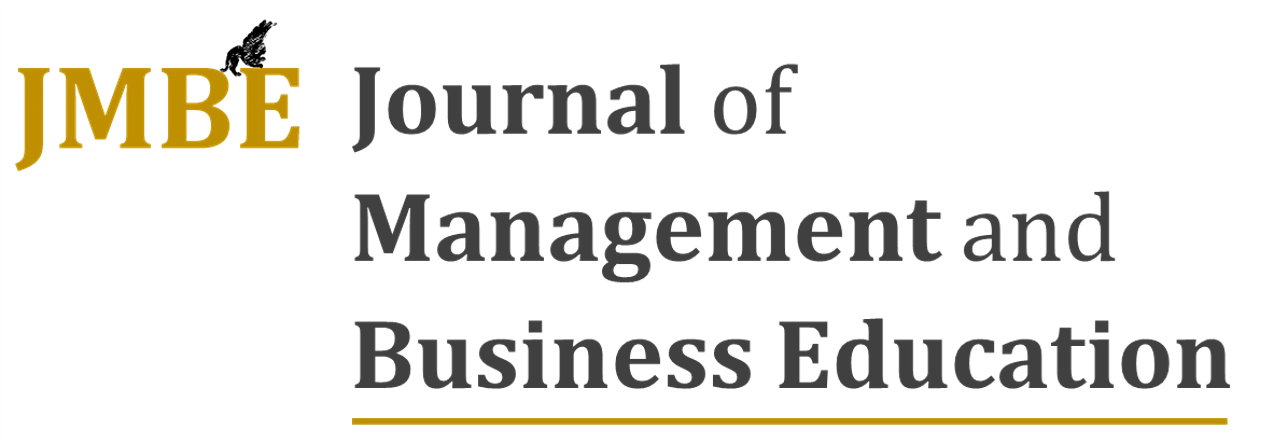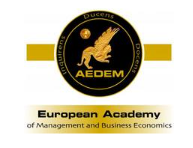Where we are: an introduction to management and business education
DOI:
https://doi.org/10.35564/jmbe.2018.0001Keywords:
education, teaching, learning, management, business, administration, literature review, state of the art, knowledge structureAbstract
This introduction provides a current vision of the situation in which research on the teaching and learning of management and business is located. A review of the state of the art in business education is developed. This analysis allows us to better understand and explain the origins of the Journal of Management and Business Education (JMBE), its mission, objectives and main characteristics, which are explained below. Finally, the first issue of the magazine is introduced and sincere thanks are offered to those for having been essential in the way of its creation.
Downloads
References
Adler, N. J.; & Harzing, A.-W. (2009). When Knowledge Wins: Transcending the Sense and Nonsense of Academic Rankings. Academy of Management Learning & Education, 8(1), 72-95.
https://doi.org/10.5465/amle.2009.37012181
Aguinis, H.; Shapiro, D. L.; Antonacopoulou, E. P.; & Cummings, T. G. (2014). Scholarly Impact: A Pluralist Conceptualization. Academy of Management Learning & Education, 13(4), 623-639.
https://doi.org/10.5465/amle.2014.0121
Antunes, D.; & Thomas, H. (2007). The Competitive (Dis)Advantages of European Business Schools. Long Range Planning, 40(3), 382-404.
https://doi.org/10.1016/j.lrp.2007.04.003
Augier, M.; & March, J. G. (2011). The roots, rituals, and rhetorics of change : North American business schools after the Second World War. Stanford Business Books.
https://doi.org/10.1515/9780804778916
Azevedo, A.; Apfelthaler, G.; & Hurst, D. (2012). Competency development in business graduates: An industry-driven approach for examining the alignment of undergraduate business education with industry requirements. The International Journal of Management Education, 10(1), 12-28.
https://doi.org/10.1016/j.ijme.2012.02.002
Barbera Ribera, M.T.; Estelles-Miguel, S.; & Dema Perez, C.M. (2015). Student opinion on the application of active methodologies in Peris-Ortiz, M. & Merigó Lindahl, J.M (eds). Sustainable Learning in Higher Education: Developing competencies for the Global Marketplace, 157-167. Springer, Switzerland.
https://doi.org/10.1007/978-3-319-10804-9_12
Bennis, W.; & O'Toole, J. (2005). How Business Schools Lost Their Way. Harvard Business Review, 83(May), 96.
Bridgstock, R. (2009). The graduate attributes we've overlooked: enhancing graduate employability through career management skills. Higher Education Research & Development, 28(1), 31-44.
https://doi.org/10.1080/07294360802444347
Cameron, K. (2006). Good or Not Bad: Standards and Ethics in Managing Change. Academy of Management Learning & Education, 5(3), 317-323.
https://doi.org/10.5465/amle.2006.22697020
Chia, R.; & Holt, R. (2008). The Nature of Knowledge in Business Schools. Academy of Management Learning & Education, 7(4), 471-486.
https://doi.org/10.5465/amle.2008.35882188
Christensen, L. J.; Peirce, E.; Hartman, L. P.; Hoffman, W. M.; & Carrier, J. (2007). Ethics, CSR, and Sustainability Education in the Financial Times Top 50 Global Business Schools: Baseline Data and Future Research Directions. Journal of Business Ethics, 73(4), 347-368.
https://doi.org/10.1007/s10551-006-9211-5
Currie, G.; & Knights, D. (2003). Reflecting on a Critical Pedagogy in MBA Education. Management Learning, 34(1), 27-49.
https://doi.org/10.1177/1350507603034001129
Datar, S.; Garvin, D., & Cullen, P. (2010). Rethinking the MBA: Business Education at a Crossroads. Harvard Business Press.
https://doi.org/10.1108/02621711111132966
Diehl, W.; Grobe, T.; Lopez, H.; & Cabral, C. (1999). Project-based learning: A strategy for teaching and learning. Boston, MA. Center for Youth Development and Education, Corporation for Business, Work and Learning.
Edelman, L. F.; Manolova, T. S.; & Brush, C. G. (2008). Entrepreneurship Education: Correspondence Between Practices of Nascent Entrepreneurs and Textbook Prescriptions for Success. Academy of Management Learning & Education, 7(1), 56-70.
https://doi.org/10.5465/amle.2008.31413862
Evans, J. M.; Trevino, L. K.; & Weaver, G. R. (2006). Who's in the Ethics Driver's Seat? Factors Influencing Ethics in the MBA Curriculum. Academy of Management Learning & Education, 5(3), 278-293.
https://doi.org/10.5465/amle.2006.22697017
García-Beltrán, A.; Martínez, R.; Jaén, J.A.; & Tapia, S. (2016). La autoevaluación como actividad docente en entornos virtuales de aprendizaje/enseñanza. Revista de Educación a Distancia, 50, artículo 14, 1-11.
https://doi.org/10.6018/red/50/14
Ghoshal, S. (2005). Bad Management Theories Are Destroying Good Management Practices. Academy of Management Learning & Education, 4(1), 75-91.
https://doi.org/10.5465/amle.2005.16132558
Giacalone, R. A.; & Thompson, K. R. (2006). Business Ethics and Social Responsibility Education: Shifting the Worldview. Academy of Management Learning & Education, 5(3), 266-277.
https://doi.org/10.5465/amle.2006.22697016
Hinings, C. R.; & Greenwood, R. (2002). Disconnects and Consequences in Organization Theory? Administrative Science Quarterly, 47(3), 411.
https://doi.org/10.2307/3094844
Hühn, M. P. (2014). You Reap What You Sow: How MBA Programs Undermine Ethics. Journal of Business Ethics, 121(4), 527-541.
https://doi.org/10.1007/s10551-013-1733-z
Kaplan, A. M.; & Haenlein, M. (2010). Users of the world, unite! The challenges and opportunities of Social Media. Business Horizons, 53(1), 59-68.
https://doi.org/10.1016/j.bushor.2009.09.003
Khurana, R. (2007). From Higher Aims to Hired Hands: The Social Transformation of American Business Schools and the Unfulfilled Promise of Management as a Profession. Princeton: Princeton University Press.
https://doi.org/10.1515/9781400830862
Khurana, R.; & Nohria, N. (2008). It's Time to Make Management a True Profession. Harvard Business Review, 86(October).
Mintzberg, H. (2004). Managers not MBAs : a hard look at the soft practice of managing and management development. Blackstone.
Neck, H. M.; & Greene, P. G. (2011). Entrepreneurship Education: Known Worlds and New Frontiers. Journal of Small Business Management, 49(1), 55-70.
https://doi.org/10.1111/j.1540-627X.2010.00314.x
Pearce, J. L.; & Huang, L. (2012). The Decreasing Value of Our Research to Management Education. Academy of Management Learning & Education, 11(2), 247-262.
https://doi.org/10.5465/amle.2011.0554
Perriton, L.; & Reynolds, M. (2004). Critical Management Education. Management Learning, 35(1), 61-77.
https://doi.org/10.1177/1350507604041165
Pfeffer, J.; & Fong, C. T. (2002). The End of Business Schools? Less Success Than Meets the Eye. Academy of Management Learning & Education, 1(1), 78-95.
https://doi.org/10.5465/amle.2002.7373679
Pfeffer, J.; & Fong, C. T. (2004). The Business School "Business": Some Lessons from the US Experience*. Journal of Management Studies, 41(8), 1501-1520.
https://doi.org/10.1111/j.1467-6486.2004.00484.x
Podolny, J. (2009). The Buck Stops (and Starts) at Business School. Harvard Business Review, 87(June), 62.
Rasche, A.; Gilbert, D. U.; & Schedel, I. (2013). Cross-Disciplinary Ethics Education in MBA Programs: Rhetoric or Reality? Academy of Management Learning & Education, 12(1), 71-85.
https://doi.org/10.5465/amle.2011.0016a
Reynolds, M. (1999). Grasping the Nettle: Possibilities and Pitfalls of a Critical Management Pedagogy. British Journal of Management, 10(2), 171-184.
https://doi.org/10.1111/1467-8551.00118
Robles, M. M. (2012). Executive Perceptions of the Top 10 Soft Skills Needed in Today's Workplace. Business Communication Quarterly, 75(4), 453-465.
https://doi.org/10.1177/1080569912460400
Rusinko, C. A. (2010). Integrating Sustainability in Management and Business Education: A Matrix Approach. Academy of Management Learning & Education, 9(3), 507-519.
https://doi.org/10.5465/AMLE.2010.53791831
Sharma, R.; Jain, A.; Gupta, N.; Garg, S.; Batta, M.; & Dhir, S.K. (2016). Impact of self-assessment by students on their learning. International Journal of Applied Basic Medical Research, 6(3), 226-229.
https://doi.org/10.4103/2229-516X.186961
Starkey, K.; Hatchuel, A.; & Tempest, S. (2004). Rethinking the Business School. Journal of Management Studies, 41(8), 1521-1531.
https://doi.org/10.1111/j.1467-6486.2004.00485.x
Starkey, K.; & Madan, P. (2001). Bridging the Relevance Gap: Aligning Stakeholders in the Future of Management Research. British Journal of Management, 12(s1), S3-S26.
https://doi.org/10.1111/1467-8551.12.s1.2
Starkey, K.; & Tiratsoo, N. (2007). The business school and the bottom line. Cambridge University Press.
https://doi.org/10.1017/CBO9780511619342
Valerio Ureña, G.; & Rodríguez Martínez, M.C. (2017). Perfil del profesor universitario desde la perspectiva del estudiante. Revista Innovación Educativa, 17(74), 109-124.
Wilton, N. (2011). Do employability skills really matter in the UK graduate labour market? The case of business and management graduates. Work, Employment and Society, 25(1), 85-100.
https://doi.org/10.1177/0950017010389244
Wilton, N. (2012). The impact of work placements on skills development and career outcomes for business and management graduates. Studies in Higher Education, 37(5), 603-620.
Downloads
Published
How to Cite
Issue
Section
License
Copyright (c) 2023 Journal of Management and Business Education

This work is licensed under a Creative Commons Attribution-NonCommercial-ShareAlike 4.0 International License.
License terms at: https://creativecommons.org/licenses/by-nc/4.0/legalcode




